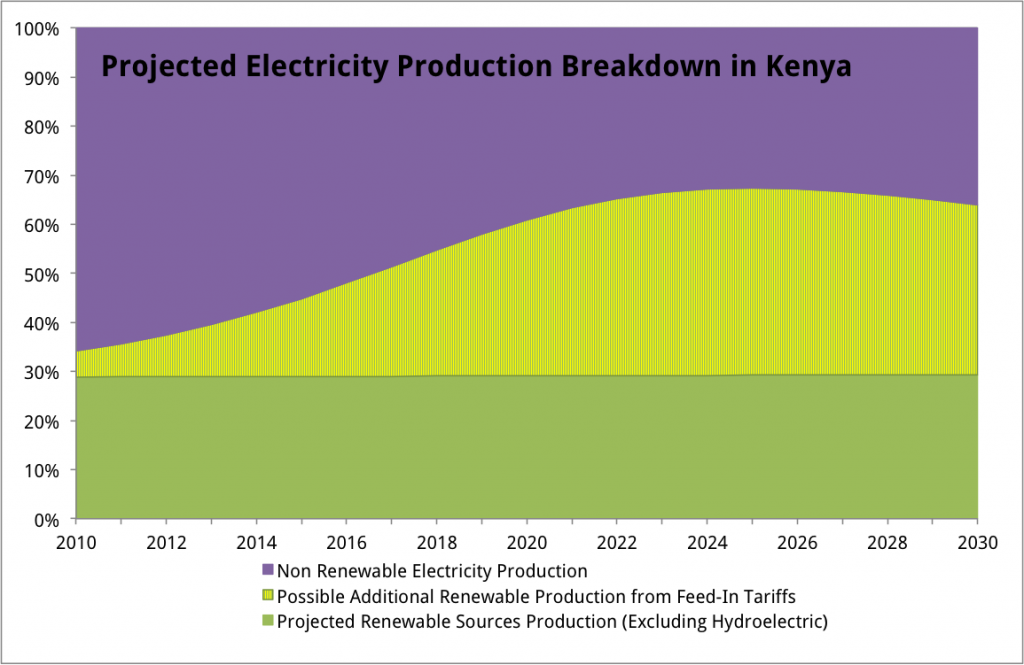As we introduced in our last post on this topic, Kenya is using several policy tools to stimulate renewable energy development and grow its national energy supply. With rapidly growing demand, the government has clearly identified renewable energy, such as solar, wind, and geothermal, as a reliable and sustainable way to increase energy supply.
Renewable energy production presents the potential for income and employment generation. It also encourages private investment while minimizing environmental harm. The new policy tools aim to reduce inefficiencies existing in conventional bidding processes for grid energy and encourage small players to participate in the development of the sector. The effort presents an exciting opportunity for new players in the market, including social entrepreneurs and impact investors, and here we’ll discuss what the policy tools mean for the growing market opportunity.
Policy Tools
The six policy papers (outlined in our previous post) focus on three main policy tools: feed-in tariffs, 0% import duties, and VAT exemption. The Scaling-Up Renewable Energy Program introduced a zero-rated (0%) import duty on renewable energy equipment and accessories in 2011. This is unusual: all goods in Kenya have an import duty unless explicitly exempted by an act of parliament. The same program removes VAT (value-added tax) on renewable energy materials, equipment, and accessories. Prior to 2011, there had been a 16% VAT on renewable energy materials.
While the VAT exemption and 0% import duty will ease the financial burden for active renewable energy companies, the feed-in tariff will have the biggest impact on overall installed renewable capacity. In 2008, the Ministry of Energy introduced a feed-in tariff for renewable energy sources, including wind, small hydropower, and bioenergy. The government later updated the feed-in tariff to include geothermal, solar, and biogas sources in 2010. The policy in its entirety is available here.
A feed-in tariff is a policy tool that governments use to increase the renewable energy supply on the grid by stimulating investment. Utility companies responsible for supplying the national grid are required to purchase electricity from renewable energy providers at a predetermined price under a Power Purchase Agreement (PPA). The price is set at a level that is purposely designed to attract and stimulate new investment in the renewable sector. The tariffs apply to grid-connected plants and are valid for a 20-year period from the beginning of the PPA. Kenya’s tariff schedule is below.
Anticipated Effects: Benefits and Growth
The most obvious benefit of the feed-in tariff is the potential for added capacity for renewables. As outlined above, the maximum capacity that the feed-in tariff will subsidize is 1750 MW added over the course of 20 years. According to UNEP, it is reasonable to expect that the feed-in tariffs will stimulate 1300 MW of installed power capacity. Taking into account the diversification of the renewable energy sources and their respective global efficiencies, we estimate that this results in a potential additional 5800 GWh produced over the duration of the tariff.
The first chart below shows projected electricity production in Kenya up to 2030. Historically, overall electricity production has increased on average at 5% per year; this is shown in purple. Production from renewables, excluding hydroelectric – shown in green – has historically increased at 4.5%. The yellow area in the chart below shows the potential additional renewable production that would come as a direct result of feed-in tariff projects. They could almost double renewable energy production.
What’s intriguing is the way that the feed-in tariffs will affect Kenya’s energy mix. We don’t expect that feed-in tariffs will accelerate overall growth, as historically the nation’s energy growth has been consistent due to careful management and diversification of its sources. If the overall energy production continues to grow consistently and an additional 1300 MW of renewable energy capacity is installed as predicted through the feed-in tariff program, energy production from renewable could make up to 60% of national energy supply. This would certainly put Kenya on the forefront of energy development in Africa.
The government’s efforts at creating a comprehensive policy will create many fringe benefits including stimulating investment and reducing the cost of peak electricity. The tariff makes renewable energy generators more attractive to potential investors thanks to the guaranteed 20-year purchase contract (PPA) at a fixed price per kWh. Additionally, feed-in tariffs have historically reduced the price of peak electricity when deployed in other markets. According to Clean Technica, peak energy prices in Germany decreased by 40% and the savings were passed onto consumers. Although this spells lower average revenue per person to the national energy suppliers (there is one state-owned and six independent providers in Kenya), reducing the price is the only way to increase the customer base in emerging markets.
The policy tools in place will allow renewables to play a significant role in closing the energy gap in Kenya and will create opportunities for entrepreneurs and investors alike. Not only is the government specifically stimulating innovation in renewable energy, it is also helping to facilitate entrepreneurship across all sectors, attract investment, and potentially double renewable energy supply. After seeing the potential increase as a result of the feed-in tariffs and understanding the fringe benefits, we’re optimistic that Kenya will be a leader in African energy innovation.
Works Cited:
Ministry of Energy. (2011). Scaling up renewable energy program. Investment plan for Kenya. Retrieved http://www.energy.go.ke/wp-content/uploads/2010/08/Updated%20%20SREP%20Draft%20Investment%20Plan-May%202011.pdf.
Shahan, Zachary. (2012). “Solar PV reducing price of electricity in Germany. Clean Technica. Retrieved from http://cleantechnica.com/2012/02/09/solar-pv-reducing-price-of-electricity-in-germany/.
UNEP. (2012). “Feed-in tariffs in Kenya.” UNEP Green Economy. Retrieved http://www.unep.org/greeneconomy/SuccessStories/FeedintariffsinKenya/tabid/29864/Default.aspx.
New here?
- Learn about what we do.
- Follow us on Twitter.
- Like us on Facebook.
- Join us on LinkedIn.
- Sign up for our mailing list.
- Catch up on past Weekly Reviews.
- Got an alternative energy or mobile tech startup for emerging markets? Apply.



